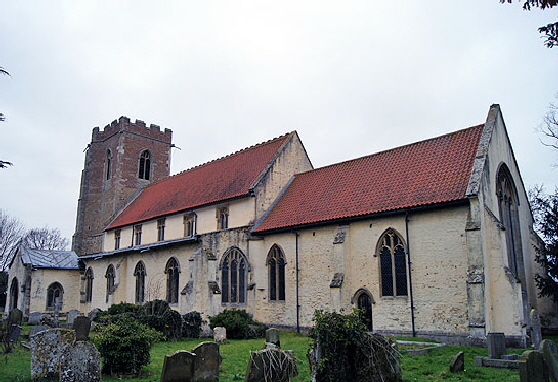|
Alphabetical List |
|
|
|
|
|
|
|
County List and Topics |
|
|
|
Please sign my Guestbook and leave feedback |
|
|
||||||||||||||||||||||
|
one could make a case for this concept being one of the greatest - and possibly the most successful - pieces of organised fraud in history! I am sure Martin Luther would have concurred. Its absence was one of the great revelations for those reading those early and supposedly heretical translations of the Bible into English. Anyway, most of this church was built in around 1400. The doorways, however, may have survived from the thirteenth century building. It is built in brick and the Church Guide suggests it is one of the first to make large-scale use of this new material. It also suggests that the windows show both Decorated and Perpendicular style elements but really that is far from obvious. Really I can’t see this myself although I’m sure the CCT is right. Make of it what you will. It’s a pretty big church mainly because it has a very long chancel, as well as aisles to north and south. The exterior is painted, which isn’t too bad, but the overall effect is somewhat marred by the plain brick tower. In truth, though, you’re not here for the architecture but for the fittings, of which the bench ends are the standout feature. When you enter the church you are greeted by a veritable forest of “poppy heads” (from the French “poupee” = doll) and know you are in for something special. The benches on the north side date from around 1500 and those on the south from 1400. They are not (sadly?) satirical or facetious as you often find in, for example, Somerset. They do, however, constitute a remarkable set of mediaeval figures giving all sorts of information about the way people dressed. Some clearly would bear a degree of interpretation but really this is a job for the real enthusiast. We can tell which figures represented biblical figures: these were the ones defaced during the Reformation or the Commonwealth. The contradiction here - not mentioned in the Church Guide - is that the lower panels of the rood screen also survive with eight paintings of saints! How can this be so? I can only surmise that the parishioners did what they did in so many places: squirrel away some of their offending treasures until such time as the iconoclasts had moved on. Other treasures must be mentioned. Firstly, the wooden “dole cupboard”. This rare survivor dates from 1639 and was used to store bread and other food for the relief of the poor. Of course, the word “dole” is today still occasionally in the UK used as a rather contemptuous word for money paid by the state to the unemployed - although, it seems to me, less than when I was a kid. Secondly, there is the fine cover over the font with a particularly large pelican in her piety. This was a popular location for this symbol of Christ’s sacrifice and you can see other examples on this site at Benefield in Northamptonshire and Ufford in Suffolk. Finally there is one of the forty or so surviving examples of a brass eagle lectern. |
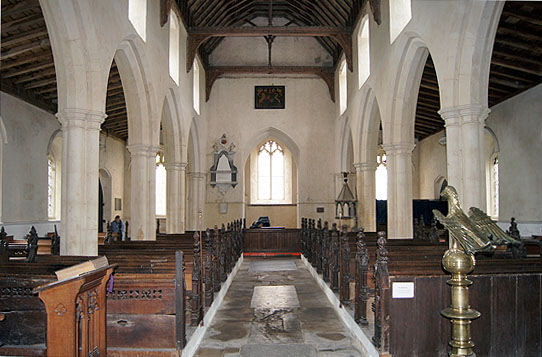 |
|||||||
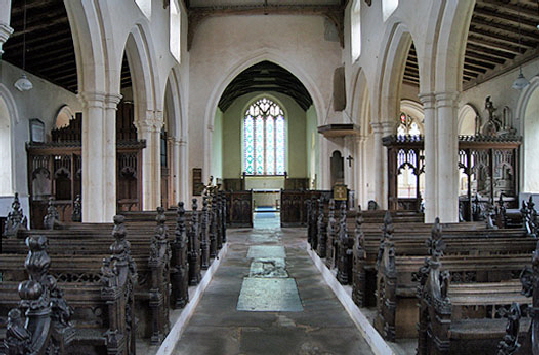 |
|||||||
|
Left: The view to the east with poppy heads lining the aisles. Right: Looking towards the west. The eagle lectern is in the right foreground, the font and its elaborate cover at the end of the north arcade. |
|||||||
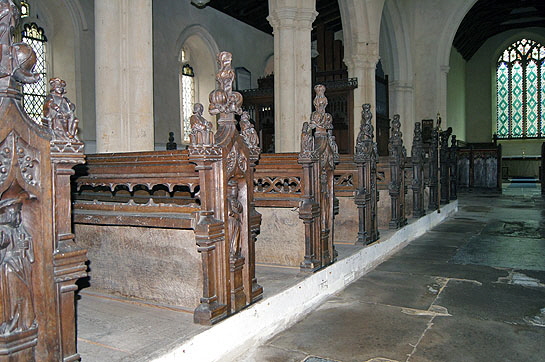 |
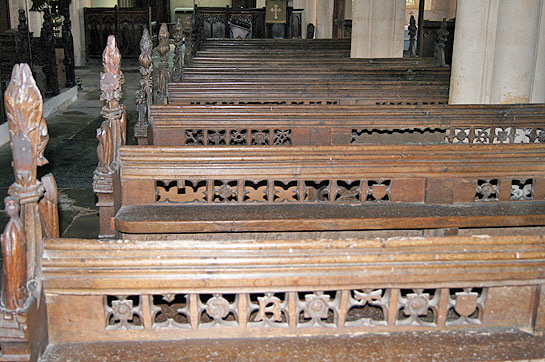 |
||||||
|
Left: As we look up the aisle you can see the visual impact of the extraordinary bench ends. Right: The benches themselves are also worth of note. The backs have elaborately carved designs, an extraordinary piece of decorative daring. |
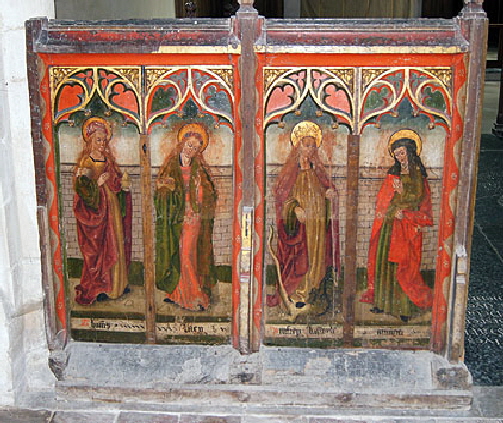 |
|||||||||||
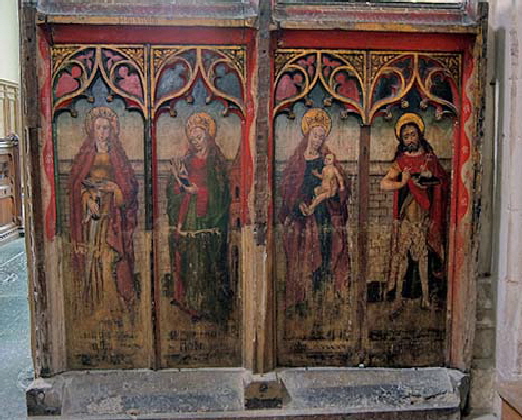 |
|||||||||||
|
The two surviving rood screen panels. Apart from their having survived at all, what is particularly noteworthy is that seven of the eight saints are female. This hardly seems likely to have been coincidental since women are rarely a majority in church art. I think the likely answer comes from the concept of “churching” women who had given birth - see the footnote below. Left: This composition has four female saints: St Mary Magdalene (with a box of ointment), St Dorothy (who she?) with a basket of flowers and fruit, St Margaret thrusting her cross into a remarkably docile dragon, and St Scholastica (er...?) with a a black cowl. Below the pictures you can see the names of the donors. The Church Guide dates the imagery to 1500-25 based upon the likely identities of some of the donors and the costume of St Scholastica. Right; There are three women here: SS Catherine (with sword), St Barbara (with a tower in which she was imprisoned by her father, and St Mary the Virgin. John the Baptist with an agnus dei is the male interloper. |
|||||||||||
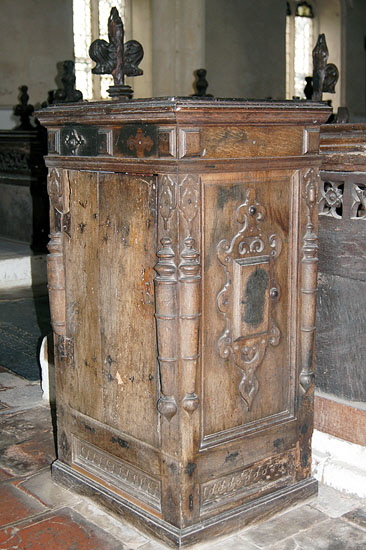 |
|||||||||||
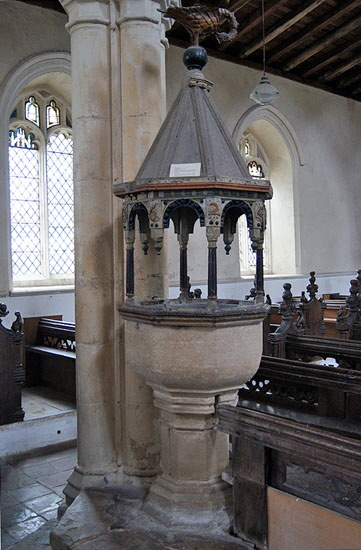 |
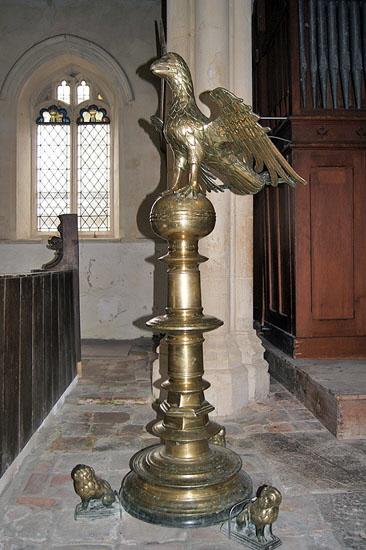 |
||||||||||
|
Left: The font is is a plain bowl but it is surmounted by an attractive cover dated 1625 and with the Pelican in her Piety at its pinnacle. Centre: The brass lectern. It was believed that the eagle was the only animal that could look directly into the sun as well as being the symbol of St John. The eagle carried forth the Word and Light of the Gospel. Right: The dole cupboard. |
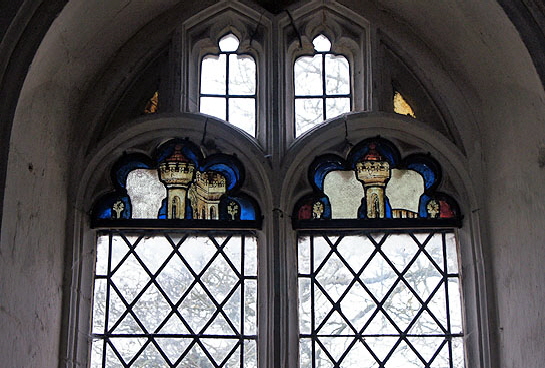 |
|||
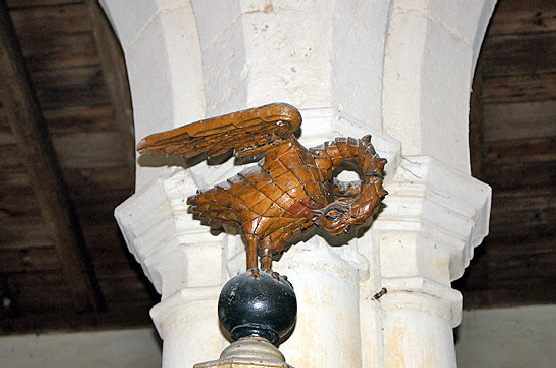 |
|||
|
Left: The Pelican in her Piety - but with no hungry chicks to be seen Right: Fragments of memorial glass are preserved in the cusps of a number of the windows. |
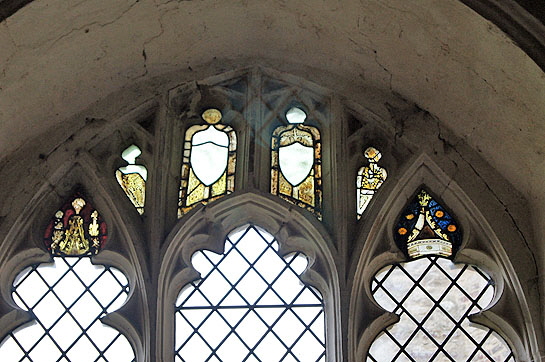 |
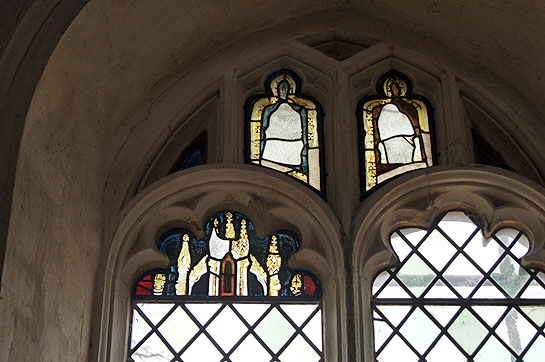 |
|||||||||||||||||||||||||||||||||||
|
More Fragments of Mediaeval Glass |
||||||||||||||||||||||||||||||||||||
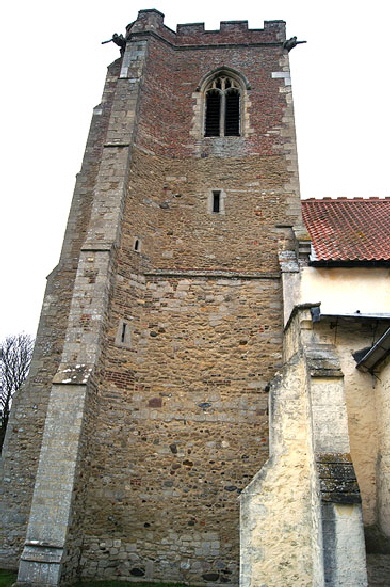 |
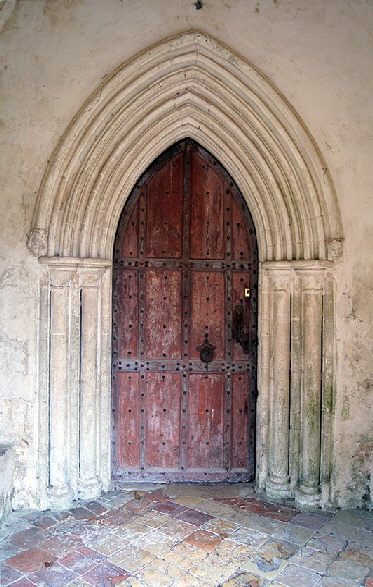 |
|||||||||||||||||||||||||||||||||||
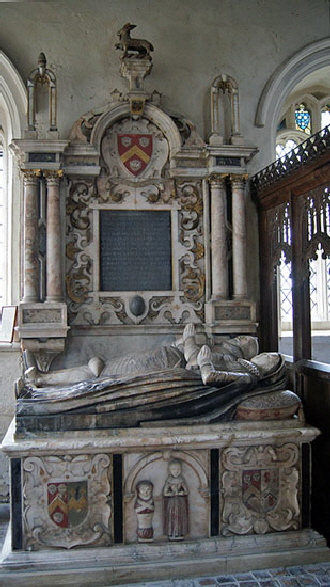 |
||||||||||||||||||||||||||||||||||||
|
Left: The Kerviles were a family long associated with this church. This monument in the south chapel is to Henry Kervile who died in 1624 and who was the last of the line. Centre: The west tower seen from the south. Right: The south doorway in Early English style and therefore predating most of the rest of the church. |
||||||||||||||||||||||||||||||||||||
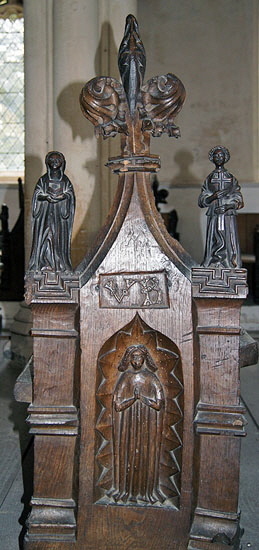 |
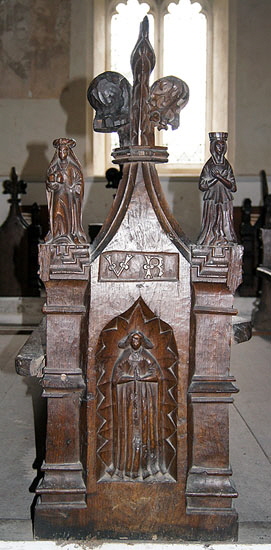 |
|||||||||||||||||||||||||||||||||||
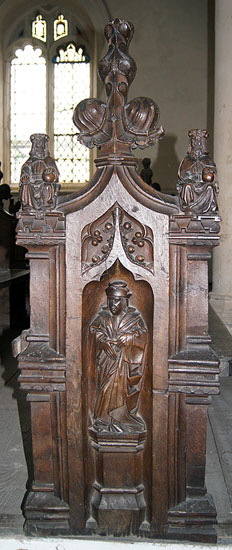 |
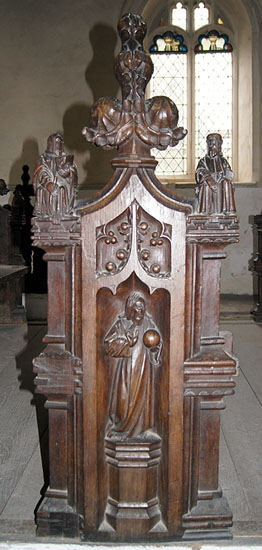 |
|||||||||||||||||||||||||||||||||||
|
There are two quite different styles visible on the bench ends here. The two on the left are noticeably less sophisticated and look older. Yet the quality of the carvings of the supporting figures either sides of the poppy heads is just as high. The Church Guide suggests that the benches on the north side are from around 1500 whilst those on the south are about 1400. They base this on a headdress worn by St Mary Magdalene and that is a generally reliable guide to dating. So it may be so. However, it still isn’t clear to me whether we are seeing two sets of carvings separated by a century or two or more carvers working concurrently. The “VR” motif, which you might be forgiven for thinking denotes “Victoria Regina” actually denotes “Virgo Regina” reflecting the church’s dedication. All of the carvings in these pictures have survived the Reformation. The main figure on the bench far right is Christ holding the world in his hands. |
||||||||||||||||||||||||||||||||||||
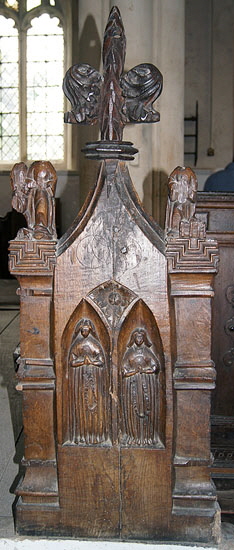 |
||||||||||||||||||||||||||||||||||||
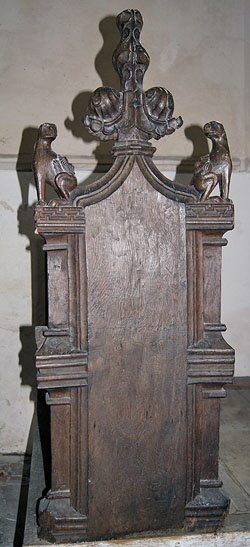 |
||||||||||||||||||||||||||||||||||||
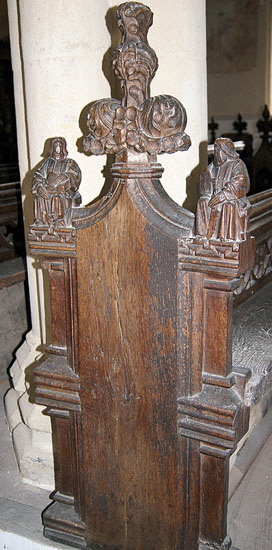 |
||||||||||||||||||||||||||||||||||||
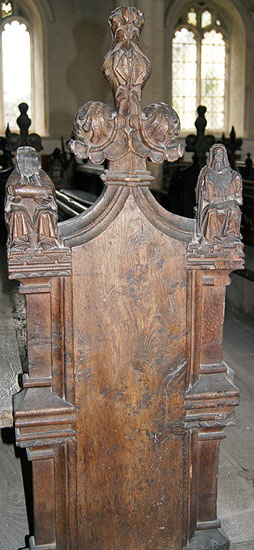 |
||||||||||||||||||||||||||||||||||||
|
Three of these four ends have blank faces which is inexplicable. We do see some defacement here. Left: The left hand figure is defaced and I have seen it described as St Simon although I don’t know why. Second Right: There are two “camels”. We can recognise them only by the odd little fringed excrescences on their backs and meant to represent humps! Far Right: Two faces have been removed here and I am unable to identify them from the remains on the iconography. |
||||||||||||||||||||||||||||||||||||
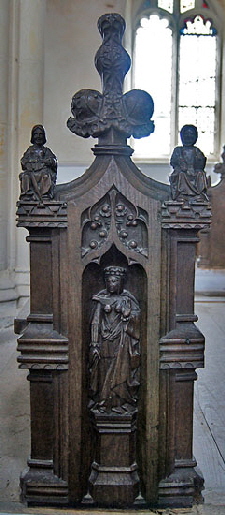 |
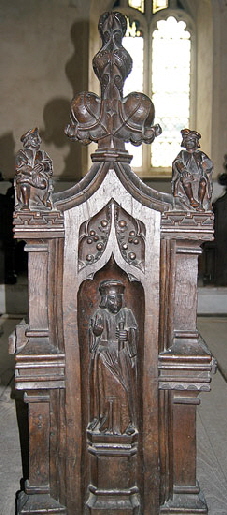 |
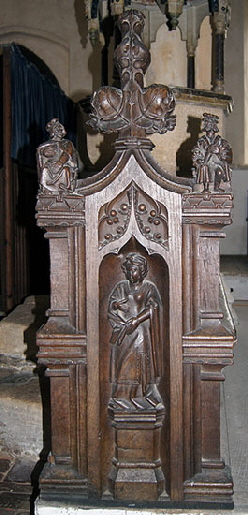 |
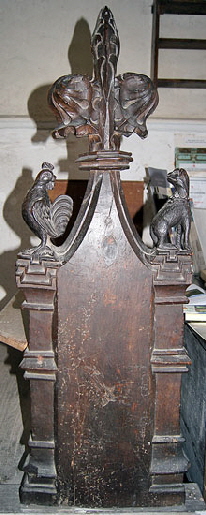 |
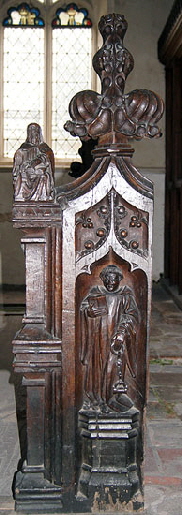 |
||||||||||||||||||||||||||||||||
|
Another series of bench ends. Perhaps the main point to note is the series of secular figures that support the poppy heads. Doubtless they represent trades or officials but only a real expert in mediaeval life would be able to decipher them today. We can recognise the main figure on the leftmost of these pictures as being St Agatha. Above her right breast (the left as we look at it) a blade is poised. The martyrology says: “ In the time of the Emperor Decius, under the judge Quinctianus, she was beaten, imprisoned, and tortured on the rack. Here breasts were cut off, and she was rolled on burning coals and potsherds. Finally she died in prison while praying to God.” I am only being a little facetious in asking how on earth she could have survived long enough to die in prison, given the agonies she had suffered! Of the remaining figures, the one in the centre picture is very clearly a somewhat comely woman with no iconography to suggest anything to do with saints and martyrs. The haphazard mix of secular and holy is not least of the surprises on these bench ends. On the far right the main figure is holding manacles. This is probably St Leonard whose miracles included the release of prisoners. |
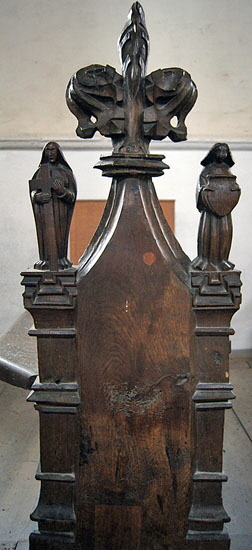 |
|||||||||||
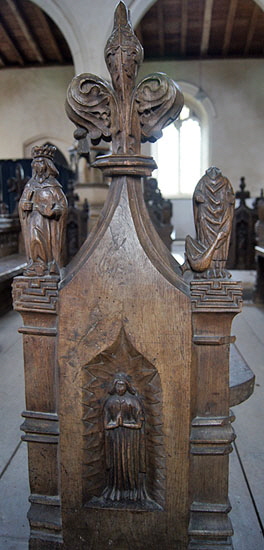 |
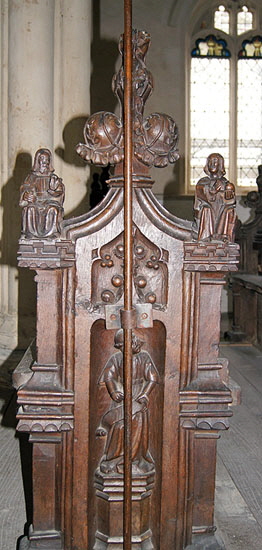 |
||||||||||
|
Three more bench ends. The defaced figure in the central picture had a goose at his feet! This was probably St Martin of Tours/ |
|||||||||||
|
Footnote - “Churching” |
|||||||||||
|
Many religions had and some still have an uneasy relationship with women and childbirth. It’s not that bearing children was seen as a matter of shame, of course (although Christianity much preferred widows and virgins to married women) but rather that it was seen by some to leave the woman “unclean”. Within the context of Christianity this probably arose from the Jewish tradition that new mothers needed “purification”, as indeed they did after menstruation. Mary herself went to the Temple for purification after the birth of Jesus. Pope Gregory the Great, in fact, deplored the notion that a new mother should need to be separated from the sacraments on account of “impurity”. The Roman Catholic Church (which seemingly has a special department for rebutting notions such as this) insists that the practice of “Churching” - a special service for new mothers - had no overtones of cleansing but was intended as a a celebration. That may well be true but as with so many aspects of religious life it is also possible pejorative connotations still existed in remoter rural communities. We need also to mention the perils of mediaeval childbirth. I am indebted to Ian Mortimer’s indispensable and wonderful “Time Travellers Guide to Mediaeval England” for the following information. One in fifty confinements ended in the death of the mother. Before you say “oh, that’s not so bad” consider the number of children a woman might bear in her lifetime. A woman bearing six children - hardly unusual in times of primitive or non-existent contraception - would have nearly a twenty five percent chance of death in childbirth. Many women had double that number of children or more. Blood loss after the birth was even more dangerous than the actual birth. Any complication needing a cesarean section would condemn the mother to certain death, As for the babies about ten percent were stillborn. One in six of babies born alive would not see their first birthdays. There was a rush to baptise babies. Remember a baby was damned through the bleakly dreadful (in my view, insane and vile) notion of “original sin” if he or she died unbaptised. Such was the rush to baptise that the new mother might not be strong enough to attend. So childbirth was perilous. A woman’s relationship with her God would have been of greater importance than ever. She would surely have prayed hard and often for the survival of herself and her baby. Never forget that the woman would have seen that as being entirely in the hands of God. “Luck”, “statistical probability” and “adverse conditions” would not have been concepts she would have recognised. Put all this together and I believe we have the most likely explanation for the preponderance of woman saints on the rood screen here. The women of the parish would have sought the intercession of those saints best placed to understand their fears. You might feel as I do that this was a welcome recognition of the place of women in mediaeval society. |
|||||||||||
